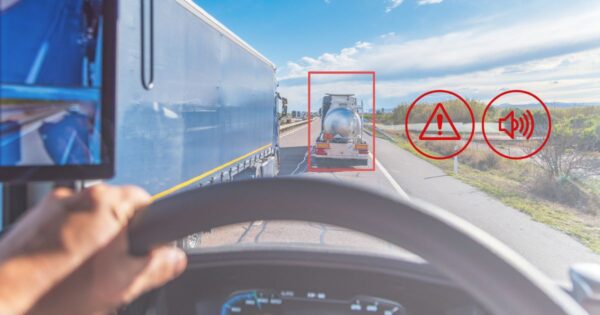Driver monitoring systems often divide opinion. Understandably, some take issue with the very idea of pointing a camera at the driver, which has earned them the “Big Brother” label. However, the reality is that a driver monitoring system acts more like a guardian than a watchful eye. They are designed to prevent accidents, reduce costs, and most importantly, save lives.
We explore how fleets can balance privacy with safety, where driver-facing cameras fit into the legal and ethical landscape, and how the future of AI-powered driver monitoring is rapidly evolving.
What is a driver monitoring system?
You might already know the basics — but here’s a quick refresher on how driver monitoring systems work and why they matter.
At their core, these driver facing cameras use AI technology and sensors to detect signs of fatigue, distraction, or risky behaviour and issue real-time in-cab audio alerts to help drivers stay focused and in control.
By detecting early signs like yawning, eye closure, phone use, or lapses in attention, these systems help foster a proactive, safety-first culture across your fleet.
More advanced systems go beyond in-cab alerts — combining driver monitoring with GPS tracking and telematics to give fleet managers a real-time, end-to-end view of driver behaviour, risk, and compliance.
This integrated approach strengthens safety, streamlines operations, and supports smarter decision-making.
Do driver-facing cameras really improve safety?
Absolutely — and the data backs it up:
- Human error is a factor in 90% of road accidents (UK Department for Transport).
- Fatigue-related crashes account for up to 20% of serious accidents on UK roads and in the US, fatigue is responsible for over 90,000 police-reported crashes annually (NHTSA).
- The AAA Foundation estimates drowsy driving contributes to up to 328,000 crashes annually in the US — 6,400 of them fatal.
- Fleets using driver monitoring systems have reported up to a 60% reduction in crash rates
- The European Union has mandated driver monitoring technology in all new vehicle types from 2024, with full compliance across all new vehicles by 2026.
Driver monitoring systems: guardian or ‘Big Brother’
We get it — not everyone’s instantly sold on driver monitoring systems. And that’s fair. No one wants to feel like they’re being watched while they work. For many drivers, the idea of in-cab driver facing cameras feels invasive, like their every move is being judged. It’s a concern we hear often, and one we take seriously.
That’s why successful implementation isn’t just about installing the tech. It’s about how it’s used. If a system constantly flags things like a simple mirror check or glancing at a dashboard, it’s not helping anyone. Calibrate it so that this doesn’t happen. And if that isn’t possible, don’t install it — it doesn’t belong in your fleet. And then there’s the issue of privacy.
Addressing driver privacy and trust
With that foundation in place, the next crucial step is addressing the concerns that drivers and fleets often have — namely, privacy and trust. It’s essential to separate myth from fact when discussing these issues:
- Consent and communication are non-negotiable. Drivers should know how the system works, what it records, and how data is used.
- Data should be protected. Anonymised, securely stored, and only accessible to authorised personnel.
- Clear policies on footage retention, usage and sharing build trust.
- Positive use cases should be highlighted: preventing fatigue crashes, exonerating drivers in false claims, and coaching for improvement.
Driver monitoring systems, when implemented properly, prioritise care over control, protecting drivers and saving lives.
Supporting drivers through feedback and coaching
Driver monitoring systems should be about empowerment, not punishment. The data these systems gather is a powerful tool for personalised coaching, helping drivers sharpen their skills and stay safe on the road.
It’s also a great way to recognise and reward those who consistently demonstrate good driving habits. Beyond that, proactive interventions can support driver wellbeing — catching early signs of fatigue or stress before they become a real risk.
In fact, we’ve seen this firsthand. After installing driver-facing cameras, one of our customers began flagging a couple of their drivers for multiple fatigue alerts. When they followed up, it turned out that some of those drivers weren’t just tired — they were experiencing underlying medical issues like diabetes or low iron levels. That kind of early insight isn’t just about safety on the road — it can genuinely improve lives off it, too.
Are driver-facing cameras legal in work vehicles?
The short answer: yes, but with important rules to follow.
In the UK and across Europe, employers can use driver-facing cameras as long as they comply with GDPR. That means having a clear safety purpose, being transparent with drivers, minimizing data collection, and keeping footage secure and used only for its intended purpose. While explicit consent isn’t always required under GDPR, clear communication and documented policies are essential.
In the United States, rules around driver-facing cameras vary by state, but employers generally must respect driver privacy, communicate openly about how the system works, and use footage responsibly. Some states, like California, have stricter regulations requiring employers to provide advance notice, have a clear safety or business reason for monitoring, and ensure the surveillance isn’t excessive.
In Canada, under PIPEDA (the country’s privacy law for private-sector organizations), driver-facing cameras are permitted if their use is reasonable, clearly justified, and communicated to drivers. Employers must explain what’s being recorded, why, and how it’s stored. Consent is typically required—though implied consent may apply if the purpose is clearly tied to safety and drivers are properly informed. Additionally, provincial laws (such as Alberta’s) may impose further requirements.
No matter where you are, the best approach is clear communication, protecting driver privacy, and using the technology responsibly to keep everyone safe.
Can you turn off driver monitoring systems?
In most professional fleets, drivers can’t simply switch off the monitoring system — it’s set up at the fleet level to keep things consistent, compliant, and safe across every vehicle.
That said, drivers absolutely deserve to know what’s being recorded and when, when alerts go off, and how the system actually works — including who can see the data.
Being open and transparent like this builds trust and makes everyone feel the system is fair, not intrusive.
The future of driver monitoring — without driver facing cameras
At CameraMatics, we’re working with AI vision specialist FotoNation on a next-gen in-cabin sensor that could help eliminate fatigue-related crashes — without the need for driver-facing cameras.
Instead of cameras, the companies are hoping to use “neuromorphic sensing” technology to create computer-intelligible images that are not readable by humans – spotting signs of drowsiness, distraction, or even medical issues.
With no camera footage, no stored video, no privacy concerns, it’s a huge leap forward for both safety and privacy. It could be a game-changer for fleets looking to protect drivers while avoiding camera concerns. You can read more about this in The Irish Times article here.

Gabriel Costache and Petronel Bigioi of FotoNation, and Daragh McDonnell, Paulo Zanni and Rob Eviston of CameraMatics
Supporting drivers and saving lives
Are driver-facing cameras an invasion of privacy? The truth is, when used responsibly, they’re not. These systems don’t record for the sake of it. They step in when it matters — not to watch, but to protect. The stats speak for themselves: they help keep drivers alert and, most importantly, save lives. And at the end of the day, isn’t that what we all want?
We have a driver monitoring system your drivers can trust — and your business can count on. Get started today.









